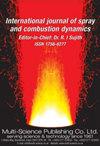A direct numerical simulation analysis of localised forced ignition in turbulent slot jets of CH 4 /CO 2 blends
IF 2.1
4区 工程技术
Q3 ENGINEERING, MECHANICAL
International Journal of Spray and Combustion Dynamics
Pub Date : 2023-03-01
DOI:10.1177/17568277221149471
引用次数: 0
Abstract
The early stages of flame evolution following successful localised forced ignition of different CH 4 /CO 2 blends in a slot jet configuration have been analysed using three-dimensional direct numerical simulations. The simulations have been conducted for three different concentration levels of CO 2 in the fuel blend composed of CH 4 and CO 2 (ranging from 0% to 20% by volume). The effects of CO 2 concentration have been analysed based on five different energy deposition scenarios which include situations where the mean mixture composition at the ignitor varies, but not its location in space, whereas other cases represent the scenarios where the mean mixture composition within the energy deposition region remains constant, but its spatial location changes with CO 2 concentration. The most favourable region for successful flame development following thermal runaway, from the mixture composition standpoint (i.e. the highest flammability factor), has been found to be displaced close to the nozzle with an increase in CO 2 concentration. The flame development following thermal runaway exhibits initial growth of hot gas kernel followed by downstream advection and eventual flame propagation along with radial expansion with a possibility of flame stabilisation irrespective of the level of CO 2 concentration. The triple flame propagation has been found to play a key role in the upstream flame propagation and eventual stabilisation. The orientation of the local flame normal plays a key role in the flame stabilisation. The lift off height has been found to increase with increasing CO 2 concentration which also adversely affect flame stabilisation for high levels of CO 2 concentration.ch4 / co2共混物紊流槽射流局部强迫点火的直接数值模拟分析
用三维直接数值模拟方法分析了不同CH4/CO2混合物在狭缝射流结构中成功局部强制点火后火焰演化的早期阶段。对由CH4和CO2组成的燃料混合物中CO2的三种不同浓度水平(按体积计从0%到20%)进行了模拟。CO2浓度的影响已经基于五种不同的能量沉积场景进行了分析,其中包括点火器处的平均混合物组成变化的情况,但不包括其在空间中的位置,而其他情况代表能量沉积区域内的平均混合物组分保持恒定的情况,但其空间位置随CO2浓度的变化而变化。从混合物成分的角度来看,热失控后火焰成功发展的最有利区域(即最高可燃系数)已被发现随着CO2浓度的增加而靠近喷嘴。热失控后的火焰发展表现出热气核的初始生长,随后是下游平流和最终的火焰传播,以及径向膨胀,无论CO2浓度水平如何,都有可能稳定火焰。三重火焰传播已被发现在上游火焰传播和最终稳定中起着关键作用。局部火焰法线的方向在火焰稳定中起着关键作用。已经发现,随着CO2浓度的增加,剥离高度增加,这也对高浓度CO2的火焰稳定性产生不利影响。
本文章由计算机程序翻译,如有差异,请以英文原文为准。
求助全文
约1分钟内获得全文
求助全文
来源期刊

International Journal of Spray and Combustion Dynamics
THERMODYNAMICS-ENGINEERING, MECHANICAL
CiteScore
2.20
自引率
12.50%
发文量
21
审稿时长
>12 weeks
期刊介绍:
International Journal of Spray and Combustion Dynamics is a peer-reviewed open access journal on fundamental and applied research in combustion and spray dynamics. Fundamental topics include advances in understanding unsteady combustion, combustion instability and noise, flame-acoustic interaction and its active and passive control, duct acoustics...
 求助内容:
求助内容: 应助结果提醒方式:
应助结果提醒方式:


